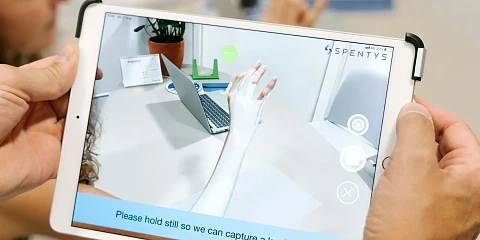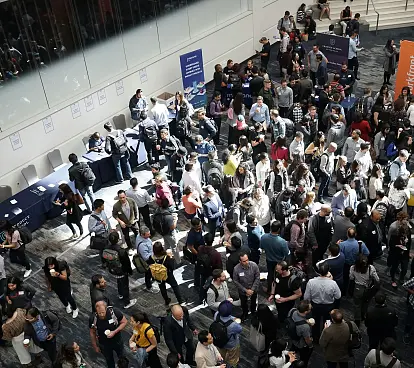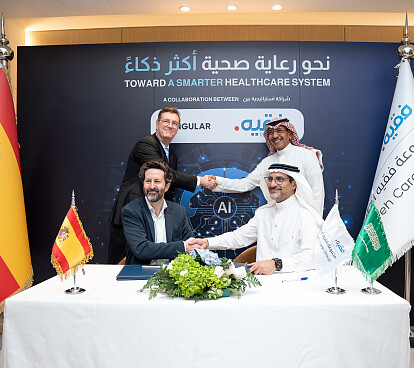
Bio-health
November 27, 2023
Technology can be transformative for the healthcare industry, but we shouldn’t just use it when we’re trying to solve problems. It is just as important, if not more, to leverage technology to improve prevention and diagnostics.
The concept of bio-health is wide-ranging and allows us to reference the biological component of health treatments. It’s using technology to understand how molecules, cells and organs work, as opposed to previous models that focused on disease progression.
Understanding how our bodies work, especially when they’re in good health, is increasingly imperative. That’s because, when disease arrives, we can see how the way that our bodies normally work has been knocked out of balance. This is another paradigm shift – focusing on the study of health instead of just sickness.
Digital technologies offer powerful tools to help scientists develop diagnostic and treatment models. They’re also key for doctors, who use them in real-world settings. We can name several digital technologies that are increasingly stepping up in the field of healthcare – everything from software to the Internet, virtual reality to quantum computing, cloud computing, big data, artificial intelligence and IoT.
Cutting-edge science
Biotechnology, omics and synthetic biology haven’t traditionally been considered digital technology. We can differentiate the two from their substrates. The first group is based on carbon, while digital technology is based on silicon. But this line is increasingly blurred. Little by little, biotechnologies are beginning to use non-biological substrates, while digital technologies are looking into how to create, for example, DNA-based computers. Another example of this connection between both worlds is bioinformatics, which has been essential in the recent research and development of areas like genetic analysis and protein design.
Since the human genome was first decoded, the use of software in basic biology and health research has exploded. Massive breakthroughs like CRISPR have drawn heavily on the research in bacterial genome databases. It is not an exaggeration to say that for biological and medical research, IT has become absolutely essential.
Applied science
When we go beyond the lab and basic research and move toward practical applications of these scientific discoveries, it becomes even more obvious just how much digital technologies have contributed. Not because there is more value here than in research, but because they are more visible to people who benefit from their practical application. With that in mind, we’ll consider how digital technologies are used in each phase of healthcare.
Prevention: If we want to protect ourselves against possible disease, we have to understand how the mechanisms that govern our body functions work. Thanks to all the discoveries being made in fields like epigenetics, neurology or those related to the microbiome, we are increasingly able to prevent some of the diseases that torment us. Here, basic science plays a crucial role.
Diagnostics: Just like with prevention, to understand how diseases work we have to understand how they manifest in our bodies. Sometimes, the effects of the disease are clear so we try to figure out exactly what’s happening. Fast and accurate diagnoses can be life-saving.
Treatment: Society and the health industry tend to put the most focus here, even though it’s not ideal. Everything that can be done before reaching this point could save a lot of suffering. So it’s important to rebalance the resources so that they touch on all phases. Doing so would benefit everyone. Scientists would have more time to dedicate to basic science. Industry could better respond to people’s needs. Society as a whole would benefit too, as better prevention and diagnostics could drastically improve the quality of life for many and reduce costs.
Trends in bio-health
Although the innovations in this field are numerous, it’s worth looking into some of the most relevant areas:
- The next generation of CRISPR technology and applications. Thanks to the CRISPR-Cas9 gene-editing system, our ability to manipulate, detect, visualize and annotate DNA and RNA sequences in living cells has improved dramatically. In addition to DNA screening, CRISPR-Cas9-based RNA screening tools are being developed for research, medicine and diagnostics.
- DNA nanotechnology-enabled drug delivery systems. The application of nanotechnology in biomedical areas like bioimaging, biosensing and drug delivery. DNA nanotechnology offers design techniques for the self-assembly of nanostructures to improve drug selection and reduce toxicity.
- Advanced biomaterials, nanoparticles and T cells in immunotherapy. Considering that immunotherapy is a powerful tool to fight cancer, there is an increase in the number of immunotherapy-based drugs, with numerous treatments in clinical and pre-clinical trials.
- Organs-on-a-Chip technology. This could be highly useful to solve one of the problems that has delayed the deployment and approval of new cancer therapies – the lack of preclinical models that can be used to identify molecular, cellular and biophysical features of human cancer progression.
- Advances in the knowledge of bi-directional microbiota-gut-brain communication. Large-scale metagenomics studies are underway to figure out how microbiome characteristics correlate with their host’s quality of life and even more specific ailments like depression. For example, faecalibacterium, which produces butyrate, and the coprococcus bacteria are consistently associated with high quality of life indicators.
The digital transformation of the healthcare sector
When we seek new ways of using technology to solve health-related problems, we shouldn’t limit ourselves to specific use cases that each one of the tools can offer. Instead, we should also look at other ideas associated with technology such as ways of working, methodologies, approaches, procedures and even business models. The business world has been working on digital transformation for a long time, and slowly but surely it’s also reaching the healthcare sector.
To achieve a digital transformation we need to go beyond digitization. In other words, think about what the use of technology brings to the general system as opposed to looking for specific utilities, for example:
- Improve user experience. The field of technology has underscored the importance of user-centered design. This has led to a change of priorities in terms of products, services, technologies and even entire organizations. In the field of health, we can aim to give people greater control over their own health, with, for example, the management of their clinical history. For this, we can use technologies like big data, cloud computing and blockchain.
- Using agile methodologies for product development. To bring digital transformation to the healthcare system, we can use a series of methodologies that will help make processes more efficient and better adapted to people's needs. Although some of these methodologies come from the world of technology, they can also be applied in the field of health to develop innovative projects.
- Open source, open Innovation and collaborative work models. These work models have been used by organizations from all types of sectors and can also have a positive impact on the health sector. Take, for example, the software used in medicine. If it is distributed in open source, it can have a much wider impact than if distributed through conventional licenses, which tend to have a higher cost and therefore be limited in its expansion.
- Developing new business models. With the rise of digital technologies, we have seen the emergence of new business models that draw on new online dynamics, such as social networks. In the health sector, these models can be applied to find new sources of income or new ways to generate business. Subscription models are one example. They’ve become popular in the field of software and digital content but could become relevant to many other sectors.
- Leveraging exponential technology. The technologies used in the digital transformation process will be those that can offer the best results in each specific case. We’ll discuss those technologies below.
Applied technologies
Digital Health, eHealth and HealthTech are a few terms that reference different technologies applied to the healthcare sector. But a lot of the technologies that apply to this field don’t carry these labels. That’s because almost every technological development is considered for its use in the healthcare sector. For instance, there are several fascinating use cases for extended reality like for surgery or treating mental health problems like phobias. Here are a few more examples:
- Software and hardware designed specifically for medical applications. There has been a boom in this type of technology, which has given rise to major companies that focus solely on developing these types of solutions. Recently, we’ve seen how the rise of open-source software and hardware and the popularization of programming languages like Python have led to many scientists and doctors creating their own technical solutions to address highly specific needs.
- Internet, cloud computing, smartphones and social networks. We have increasingly been witnessing the rise of these digital technologies in the healthcare sector. Online communities like Patients Like Me have helped thousands of people improve their health, build community and share their problems with people in similar circumstances. Many doctors and scientists also use the social network to learn more about the experiences of people with certain medical conditions to find solutions.
- IoT and wearables. We’re entering into a new phase of development for healthcare technology thanks to the expansion of wearable devices. They integrate technology into things like clothing, watches or jewelry to monitor vital signs. Here we could highlight Apple’s smartwatch, which has a specific program directed at doctors so they can better monitor and understand their patients.
- Big data and artificial intelligence. AI, more than any other technology, has the potential to revolutionize the healthcare sector. And for it to function you need big data and other technologies like cloud computing. We’re already seeing advances like machine learning and deep learning being applied to the healthcare sector in terms of image recognition. For instance, technology can help identify cancer in X-rays. The options with AI are almost endless, but we’d also like to mention federated learning, which can help process health data without threatening privacy.
- Robotics, 3D printing and exoskeletons. Among the many advances, we find surgical robots, robotic structures to improve mobility or 3D bioprinters that can create tissues and organs. Although it may seem like science fiction, the reality is that we are talking about applications that are increasingly used over previous models. Take, for example, robotic exoskeletons or prosthetic limbs, which have made great strides, not only in terms of design, adaptation and implantation, but also in terms of cost reduction.
- Blockchain for the management and security of data. Thanks to its cryptographic design that is difficult to hack, this could be the solution for the management of patients' medical records. At the moment, many people's medical data is very poorly handled, with very different criteria being applied regarding its ownership, access and use. There should be a better regulation that unifies the management of the data and returns the control of personal information to the patients.
- Cybersecurity. Technologies related to cybersecurity are increasingly important and must be taken into account to avoid the problems derived from attacks carried out by cybercriminals. This is critical in the healthcare sector due to the sensitive nature of the data of patients, healthcare centers and staff.
- Quantum computing. The potential for subatomic particles to act as an alternative to the transistors that currently make computers work has been studied for years. But it was not until a few years ago that researchers began building the first quantum computers and the first practical uses could be seen. Although this technology is in an incipient phase, it is already demonstrating the possibility to improve computation capacity. This could be very useful, for example, to design new molecules and materials.
- VR, AR, mixed and extended reality. All the variants of VR offer different practical applications. They revolve around images and video and aim to boost our ability to interact with digital content through multiple devices. Medical professionals can derive great value from using these technologies, as they help amplify their senses and ability to visualize information. Many players in the sector are unleashing their imagination around these tools to develop new ways to improve health, as we can see below.
How the healthcare sector can leverage AR and VR
Virtual and augmented reality are already being used in the sector, primarily through superimposing digital information onto the physical world in real-time. This is being seen in medicine, which can help make processes more agile and efficient.
AR and VR are being used increasingly to develop applications that can be used by doctors and surgeons in training. Simulators, for instance, can help improve precision for surgeons. This gives more people real experience for diagnostics and surgeries, therefore improving knowledge and applied practice.
The Microsoft HoloLens can also be used in anatomy classes, offering users the ability to see holograms superimposed on reality that provide information. CAE Healthcare is the first company to harness this potential to guide users through medical simulations using VimedixAR, where medical students can examine the 3D anatomy of a manikin. There is another service for cardiology, which allows a collaborative experience with more surgeons.
Likewise, this technology can help doctors in real surgical interventions. For example, through using streaming and remote connections, doctors can monitor operations from a distance. Physical monitors in the operating room can also be replaced with virtual monitors and voice commands. They can also be used as an aid in psychological therapy or remote diagnosis, combining hardware, augmented reality and artificial intelligence
On the other hand, the Abbvie company uses VR/AR technology for chronic pathologies, which helps patients to receive reliable information from the company. They also combine it with gamification to encourage patients to follow a series of medical guidelines through rewards.
Other technological applications for health
Now that we know which digital technologies are going to have the greatest impact on medicine and health, we are going to present some specific use cases where one or more of these technologies can be applied.
- Electronic health records. Data is increasingly valuable, especially now that we have the tools to process it. With patient health data, properly anonymized, data scientists can detect trends, find patterns, carry out studies of diseases or investigate their possible causes. But without data, scientists are blind and find it much more difficult to conduct their research. The same happens with doctors. If they do not have the health history of a patient, it will be much more difficult to make a diagnosis. That’s why it is important to find a medical data management model that takes advantage of data at the research level but doesn’t undermine the right to privacy.
- IT systems for health management. We have software with a huge ability to address the needs of many disciplines and activities in the healthcare sector. A multitude of applications have been developed here for all kinds of uses, and it is invaluable for developers to work closely with scientists and doctors to devise new personalized computing tools**.**
- Telemedicine, mHealth and health apps. Telemedicine brings doctors closer to the patients, which reduces the need to travel and waiting times. It also allows for real-time monitoring of the patient's health. Large investments are being made in this area, especially after the advent of the Covid-19 pandemic, which created the need to see patients at a distance.
- Data-driven decision-making. Data is the raw material that can offer the greatest value to the healthcare sector, but it also has certain characteristics that make it difficult to manage. But we have increasingly better tools to process the data respectfully and use it to make better decisions. The patients should be the first people to see the benefit of this when they can see that their medical history is being properly managed and used to make better decisions.
- Environmental Intelligence and IoT. The growing number of devices connected to the internet that exists in our homes, workplaces, cars, clothes and accessories can become an extension of individuals while connecting them with services related to health. Virtual assistants like Alexa may become be very useful in the coming years, facilitating access to digital services for people who have difficulty using other devices.
- Telesurgery. Here we find major advances with the development of surgical robots such as da Vinci, which are continuously improving to make the most of the latest technologies like 5G. This next-generation network will offer better connectivity and latency, which will be very useful when carrying out surgeries over long distances in real-time.
- Telerehabilitation. This is the stage that usually comes after surgery. Here, telemedicine can connect the doctor with the patient from a distance, so that all the necessary rehabilitation processes can be carried out in the best way possible.
- Alert systems. We are increasingly aware of the need to have adequate health risk alert systems, as well as prevention alerts, which monitor several socio-health aspects. Here, we return to IoT technologies and 5G. Thanks to Edge Computing, 5G will allow data generated by the IoT sensors to be processed with greater efficiency, boosting their ability to monitor in real-time.
- Remote education. Both health professionals and citizens can take great advantage of technologies such as virtual and augmented reality to better understand certain aspects of medicine like treatments, prevention and healthy habits. These topics are usually dealt with in the educational field, but which could now reach more of the general public thanks to all these digital technologies. At the same time, it is becoming easier for health professionals to access content. Digital technologies facilitate much-needed continuous training that can help doctors provide better services to their patients.
Our latest news
Interested in learning more about how we are constantly adapting to the new digital frontier?

Event
October 20, 2025
Sngular is heading to the Global Health Exhibition 2025 in Riyadh, Saudi Arabia

Corporate news
April 22, 2025
Sngular and Fakeeh Care Group join forces to create an AI Center of Excellence in KSA

Insight
April 7, 2025
World Health Day in the AI revolution era

Tech Insight
March 5, 2025
AI Governance: Challenges and Perspectives